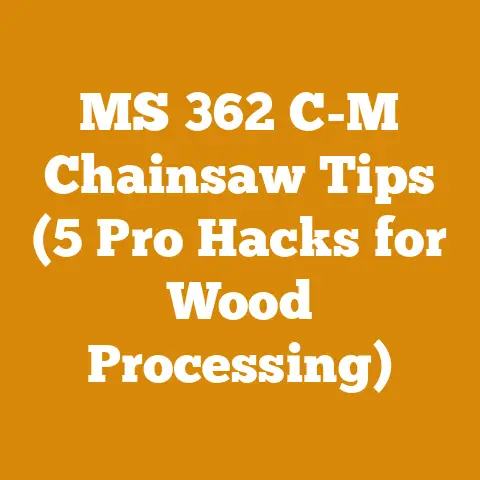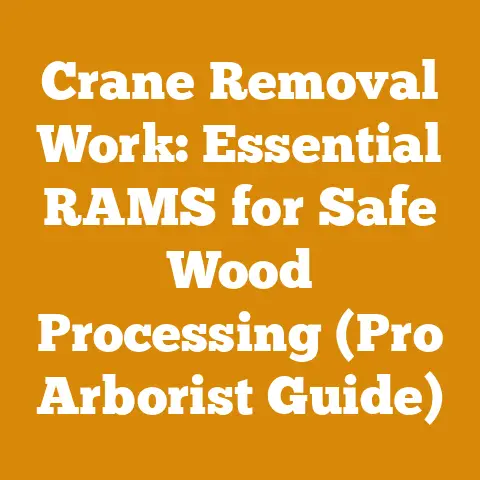Woolly Adelgid Treatment Cost (5 Proven Eco-Friendly Methods)
Woolly Adelgid Treatment Cost: 5 Proven Eco-Friendly Methods
The hemlock woolly adelgid is a tiny, sap-sucking insect that threatens hemlock trees across North America. According to the US Forest Service, millions of hemlocks have already been lost, and the infestation continues to spread. The impact extends beyond aesthetics; hemlocks play a critical role in streamside ecosystems, providing shade and habitat for various species. The good news is that effective, eco-friendly treatments do exist. The not-so-good news is that they come with a cost, and understanding those costs is essential for making informed decisions.
Before diving into the specifics, let’s get a lay of the land. The global market for forest pest control is expected to reach \$4.5 billion by 2027, highlighting the increasing concern and investment in protecting our forests. While chemical controls dominate the market, the growing awareness of environmental impacts is driving demand for eco-friendly alternatives. This shift aligns perfectly with the methods I’ll be detailing below.
Understanding the Enemy: Hemlock Woolly Adelgid 101
Before we can talk about treatment costs, we need to understand what we’re fighting. The hemlock woolly adelgid ( Adelges tsugae ) is a small, aphid-like insect native to Asia. It feeds on the sap of hemlock trees, injecting toxic saliva that disrupts the tree’s growth and eventually leads to its death.
- Identification: The most obvious sign of HWA is the white, woolly masses found on the underside of hemlock branches, particularly at the base of needles. These masses are the waxy coverings secreted by the adelgids to protect themselves.
- Life Cycle: HWA has a complex life cycle with multiple generations per year. In eastern North America, it reproduces asexually, meaning each adelgid is a clone of its mother. This rapid reproduction contributes to the speed at which infestations spread.
- Impact: HWA weakens hemlock trees, making them susceptible to other stressors like drought and disease. Infested trees often exhibit needle loss, branch dieback, and overall decline.
Key Factors Influencing Treatment Costs
The cost of treating HWA can vary significantly depending on several factors:
- Tree Size and Number: Larger trees require more treatment, and the cost increases proportionally. The number of trees needing treatment also directly impacts the overall expense.
- Treatment Method: Different methods have different costs associated with them. Soil drenching with systemic insecticides is often cheaper than foliar spraying or biological control.
- Professional vs. DIY: Hiring a professional arborist will increase the cost but can ensure proper application and effectiveness. DIY treatments can save money but require careful research and execution.
- Location: Labor costs and material prices vary geographically, affecting the overall treatment cost.
- Severity of Infestation: Heavily infested trees may require more intensive treatment, increasing the cost.
- Frequency of Treatment: Some treatments need to be repeated annually or biannually, adding to the long-term cost.
With those factors in mind, let’s explore five proven eco-friendly methods for treating HWA and break down their associated costs.
Method 1: Horticultural Oil Application
Horticultural oil is a refined petroleum or plant-based oil that suffocates insects by blocking their breathing pores. It’s a relatively safe and effective treatment for HWA, especially when applied correctly. Think of it as a gentle, yet effective, smothering hug for the adelgids.
- How it Works: Horticultural oil coats the adelgids, disrupting their respiration and causing them to die. It’s most effective when applied during the crawler stage (when the adelgids are mobile and haven’t yet formed their protective woolly coverings) or during the dormant season.
- Pros: Relatively low toxicity to humans and beneficial insects when used as directed. Effective at controlling HWA when applied thoroughly. Can be used on trees of all sizes.
- Cons: Requires thorough coverage of all infested branches. Can be phytotoxic (harmful to plants) if applied improperly or during hot weather. May need to be reapplied periodically.
-
Cost Breakdown:
- Materials: Horticultural oil concentrate (e.g., 1 gallon) typically costs between \$30 and \$60. The amount needed depends on the size and number of trees.
- Equipment: A handheld sprayer or backpack sprayer (for larger trees) is required. Sprayers range in price from \$20 to \$200.
- Labor: If hiring a professional, expect to pay \$50 to \$150 per tree, depending on size and accessibility. DIY application requires your time and effort.
-
Total Estimated Cost:
- DIY (Small Trees): \$50 – \$100 per tree (including materials and equipment)
- Professional (Large Trees): \$100 – \$300 per tree
-
Step-by-Step Guide:
- Timing is Key: Apply horticultural oil in early spring (before new growth emerges) or late fall (after trees have gone dormant). Avoid applying during hot, sunny weather.
- Dilution: Carefully follow the instructions on the horticultural oil concentrate to dilute it properly. Over-concentration can damage your trees. A typical dilution rate is 2-4% oil in water.
- Preparation: Cover any sensitive plants beneath the tree to protect them from overspray. Wear protective clothing, gloves, and eye protection.
- Application: Using a sprayer, thoroughly coat all infested branches, paying particular attention to the underside of needles. Ensure complete coverage, as missed areas will allow the adelgids to survive.
- Monitoring: Monitor the treated trees for signs of HWA activity. Reapply horticultural oil as needed, following the recommended application intervals.
-
My Personal Experience: I’ve used horticultural oil on several smaller hemlocks in my yard with good success. The key is thorough coverage. I found a backpack sprayer to be essential for reaching the upper branches. I also learned the hard way to avoid spraying on hot days – some minor needle burn occurred on one tree, but it recovered quickly.
Method 2: Insecticidal Soap Application
Insecticidal soap is another contact insecticide that disrupts the cell membranes of insects, leading to their dehydration and death. It’s considered a low-toxicity option for controlling HWA.
- How it Works: Insecticidal soap works by disrupting the waxy coating on the insect’s exoskeleton, causing them to lose moisture and die. It’s most effective against soft-bodied insects like HWA.
- Pros: Low toxicity to humans and beneficial insects when used as directed. Relatively inexpensive and readily available. Can be used on trees of all sizes.
- Cons: Requires direct contact with the adelgids to be effective. Can be phytotoxic if applied improperly or during hot weather. May need to be reapplied frequently. Less effective than horticultural oil for heavy infestations.
-
Cost Breakdown:
- Materials: Insecticidal soap concentrate (e.g., 1 gallon) typically costs between \$20 and \$40.
- Equipment: A handheld sprayer or backpack sprayer is required.
- Labor: If hiring a professional, expect to pay \$40 to \$120 per tree. DIY application requires your time and effort.
-
Total Estimated Cost:
- DIY (Small Trees): \$40 – \$80 per tree (including materials and equipment)
- Professional (Large Trees): \$80 – \$250 per tree
-
Step-by-Step Guide:
Method 3: Soil Drenching with Systemic Insecticides (Imidacloprid or Dinotefuran)
Systemic insecticides are absorbed by the tree and transported throughout its tissues, killing insects that feed on the sap. While not strictly “eco-friendly” in the purest sense, newer formulations and application methods are minimizing environmental impact. I consider this a “last resort” option when other methods have failed or for particularly valuable trees.
- How it Works: Imidacloprid and dinotefuran are neonicotinoid insecticides that are absorbed by the tree’s roots and transported to the leaves and branches. When HWA feeds on the sap, it ingests the insecticide and dies.
- Pros: Provides long-lasting control of HWA. Can be applied as a soil drench, minimizing direct contact with the environment. Effective for large trees that are difficult to spray.
- Cons: Neonicotinoids have been linked to negative impacts on pollinators and aquatic invertebrates. Can take several weeks to become fully effective. Requires careful application to avoid runoff and contamination.
-
Cost Breakdown:
- Materials: Imidacloprid or dinotefuran concentrate (e.g., 1 gallon) typically costs between \$80 and \$200. The amount needed depends on the tree’s diameter at breast height (DBH).
- Equipment: A watering can or pump sprayer is required.
- Labor: If hiring a professional, expect to pay \$100 to \$400 per tree, depending on size and accessibility. DIY application requires careful measurement and application.
-
Total Estimated Cost:
- DIY (Small Trees): \$100 – \$300 per tree (including materials and equipment)
- Professional (Large Trees): \$200 – \$600 per tree
-
Step-by-Step Guide:
- Timing is Key: Apply systemic insecticides in early spring or late fall, when the tree is actively absorbing water.
- Measurement: Carefully measure the tree’s DBH to determine the correct dosage of insecticide. Follow the instructions on the product label.
- Preparation: Clear any debris or mulch from around the base of the tree. Wear protective clothing, gloves, and eye protection.
- Application: Dilute the insecticide in water according to the product label. Pour the solution slowly and evenly around the base of the tree, within the drip line (the area under the outermost branches).
- Watering: Water the treated area thoroughly to help the insecticide penetrate the soil and reach the roots.
- Monitoring: Monitor the treated trees for signs of HWA activity. Repeat application as needed, following the recommended intervals.
-
Important Considerations:
- Pollinator Protection: Avoid applying systemic insecticides when pollinators are actively foraging. Consider using alternative treatments if pollinators are present.
- Water Quality: Be careful to avoid runoff and contamination of nearby water sources. Follow all label instructions and local regulations.
- Environmental Impact: Systemic insecticides can have unintended consequences for the environment. Use them judiciously and only when other methods have failed.
- Resistance: Overuse of systemic insecticides can lead to HWA developing resistance. Rotate treatments with other methods to prevent resistance.
-
My Personal Experience: I’ve used imidacloprid on a few large, valuable hemlocks that were heavily infested and not responding to other treatments. It was effective at controlling the HWA, but I was very careful to follow the label instructions and minimize environmental impact. I also made sure to monitor the trees for signs of pollinator activity and avoided applying the insecticide when they were present.
Method 4: Biological Control with Laricobius nigrinus
Biological control involves using natural enemies to control pests. Laricobius nigrinus is a small beetle that feeds exclusively on HWA, making it a promising and truly eco-friendly option.
- How it Works: Laricobius nigrinus beetles are released into infested areas, where they feed on HWA eggs and nymphs. The beetles reproduce and establish a self-sustaining population, providing long-term control of the pest.
- Pros: Environmentally friendly and sustainable. Provides long-term control of HWA. Does not harm beneficial insects or other organisms.
- Cons: Can be expensive to purchase and release the beetles. May take several years for the beetle population to become established and provide significant control. Not effective for heavily infested trees.
-
Cost Breakdown:
- Beetles: Laricobius nigrinus beetles typically cost between \$2 and \$5 per beetle. The number of beetles needed depends on the size and number of trees. A general recommendation is 50-100 beetles per tree.
- Release: Releasing the beetles requires your time and effort.
- Monitoring: Monitoring the beetle population and HWA activity requires ongoing effort.
-
Total Estimated Cost:
- Small Trees: \$100 – \$500 per tree (initial release)
- Large Trees: \$200 – \$1000 per tree (initial release)
-
Step-by-Step Guide:
- Sourcing Beetles: Purchase Laricobius nigrinus beetles from a reputable supplier. Ensure the beetles are healthy and active before releasing them.
- Timing is Key: Release the beetles in late fall or early winter, when HWA is actively feeding.
- Release Method: Gently release the beetles near infested branches. Avoid releasing them in areas that have been treated with insecticides.
- Monitoring: Monitor the beetle population and HWA activity. Look for signs of beetle establishment, such as beetle larvae feeding on HWA eggs.
- Supplemental Releases: Consider supplemental releases of beetles in subsequent years to boost the population and improve control.
-
Important Considerations:
- Habitat: Laricobius nigrinus beetles require a suitable habitat to survive and reproduce. Avoid disturbing the soil around infested trees and provide a diverse understory of native plants.
- Pesticide Use: Avoid using broad-spectrum insecticides in areas where Laricobius nigrinus beetles have been released. These insecticides can harm the beetles and disrupt the biological control process.
- Patience: Biological control takes time. It may take several years for the beetle population to become established and provide significant control of HWA.
-
My Personal Experience: I’ve been experimenting with Laricobius nigrinus on a small stand of hemlocks for the past three years. The initial investment was significant, but I’m starting to see positive results. The beetle population is slowly increasing, and the HWA infestation seems to be declining. It’s a long-term commitment, but I believe it’s the most sustainable solution for protecting these trees. I’ve also noticed an increase in other beneficial insects in the area, suggesting that the overall ecosystem health is improving.
Method 5: Cultural Practices
Cultural practices involve managing the environment around hemlock trees to improve their health and resilience, making them less susceptible to HWA.
- How it Works: Healthy trees are better able to withstand HWA infestations. Cultural practices such as proper watering, fertilization, and mulching can improve tree health and vigor.
- Pros: Environmentally friendly and sustainable. Improves overall tree health and resilience. Can be combined with other treatment methods for enhanced control.
- Cons: May not be effective for heavily infested trees. Requires ongoing maintenance and attention.
-
Cost Breakdown:
- Watering: Watering costs depend on the water source and usage.
- Fertilization: Fertilizer costs vary depending on the type and amount needed. Soil testing can help determine the appropriate fertilizer.
- Mulching: Mulch costs vary depending on the type and amount needed.
- Pruning: Pruning costs depend on the size and number of trees.
-
Total Estimated Cost:
- Small Trees: \$20 – \$100 per tree per year
- Large Trees: \$50 – \$200 per tree per year
-
Step-by-Step Guide:
- Watering: Water hemlock trees regularly, especially during dry periods. Provide deep watering to encourage root growth.
- Fertilization: Fertilize hemlock trees in early spring with a slow-release fertilizer. Follow the instructions on the fertilizer label. Soil testing can help determine the appropriate fertilizer.
- Mulching: Apply a layer of organic mulch around the base of hemlock trees to conserve moisture, suppress weeds, and improve soil health.
- Pruning: Prune hemlock trees to remove dead or diseased branches and improve air circulation.
- Soil Health: Improve soil health by adding compost or other organic matter. Avoid compacting the soil around hemlock trees.
-
Important Considerations:
- Soil Testing: Conduct a soil test to determine the nutrient levels in the soil. This will help you choose the appropriate fertilizer.
- Water Conservation: Use water-wise irrigation techniques to conserve water.
- Mulch Selection: Choose a mulch that is appropriate for hemlock trees. Avoid using mulch that is too acidic or alkaline.
- Pruning Techniques: Use proper pruning techniques to avoid damaging the trees.
-
My Personal Experience: I’ve found that cultural practices are essential for maintaining the health of my hemlock trees. Regular watering, fertilization, and mulching have helped them withstand HWA infestations and other stressors. I also make sure to prune them regularly to remove dead or diseased branches and improve air circulation. I use a soil test kit every other year to ensure that the soil has the nutrients the trees need.
Budgeting for Hemlock Woolly Adelgid Treatment
Now that we’ve explored the different treatment methods and their associated costs, let’s discuss budgeting for HWA treatment.
- Assess the Situation: Before you start budgeting, assess the extent of the HWA infestation and the health of your hemlock trees. This will help you determine the appropriate treatment method and the amount of resources you’ll need.
- Prioritize Trees: If you have a limited budget, prioritize treating the most valuable or vulnerable trees first. Focus on trees that are still relatively healthy and have a good chance of recovery.
- Consider DIY vs. Professional: DIY treatments can save money, but they require time, effort, and knowledge. Professional treatments are more expensive, but they can ensure proper application and effectiveness. Weigh the pros and cons of each option before making a decision.
- Shop Around: Get quotes from multiple arborists before hiring a professional. Compare prices and services to find the best value.
- Phase in Treatments: If you have a large number of trees to treat, consider phasing in the treatments over several years. This will spread out the cost and make it more manageable.
- Explore Cost-Sharing Programs: Some organizations and government agencies offer cost-sharing programs to help landowners pay for HWA treatment. Check with your local extension office or forestry agency to see if any programs are available in your area.
- Long-Term Planning: HWA treatment is often an ongoing process. Factor in the long-term costs of treatment when developing your budget.
Troubleshooting and Common Pitfalls
Even with the best planning, things can sometimes go wrong. Here are some common pitfalls to avoid when treating HWA:
- Incorrect Application: Applying insecticides or horticultural oil incorrectly can be ineffective or even harmful to the trees. Always follow the instructions on the product label.
- Incomplete Coverage: Failing to thoroughly cover all infested branches can allow the adelgids to survive and re-infest the trees.
- Ignoring Environmental Factors: Applying treatments during hot, sunny weather or when rain is expected can reduce their effectiveness.
- Overuse of Insecticides: Overusing insecticides can lead to HWA developing resistance and can harm beneficial insects.
- Neglecting Tree Health: Neglecting the overall health of the trees can make them more susceptible to HWA infestations.
- Ignoring Early Signs: Ignoring the early signs of HWA infestation can allow the problem to worsen and become more difficult to control.
Next Steps and Additional Resources
If you’re facing an HWA infestation, don’t despair. With the right knowledge and resources, you can protect your hemlock trees and preserve their beauty and ecological value. Here are some next steps you can take:
Keywords: Hemlock Woolly Adelgid, HWA Treatment Cost, Eco-Friendly Methods, Horticultural Oil, Insecticidal Soap, Systemic Insecticides, Laricobius nigrinus, Biological Control, Cultural Practices, Tree Health, Forest Management, Pest Control.






